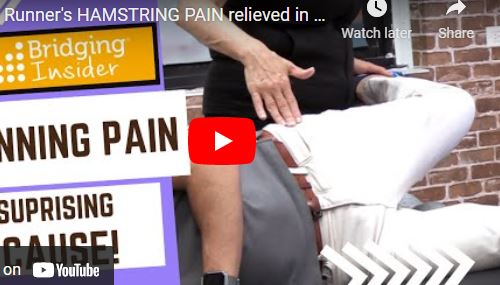Runner’s Hamstring Has Him Sidelined. Why?
Runner hamstrung over hamstring issueOur YouTube guest this week had a weird running injury which wasn’t getting better with rest and the usual stretching. The pain limited his ability to get through the day, to enjoy summer, and let off his work stress via exercise! The best comment came after we finished and took off microphones. He exclaimed, “I can put my shoes on without pain!” The hamstring pain had truly impacted every little part of his daily life. Take a look to see how we solved part of the mystery pain. |
Let’s use the Bridging® framework to breakdown Bob’s hamstring issue
To help understand why an injury is not recovering as expected we look to the past for additional clues. A prior injury often provides insights to how, where, and how long the body has been compensating.
Here are some key events from Bob’s past that contributed to his current issues:
- Infancy: Bob’s leg was turned in from birth and needed a cast, then braces to straighten it.
- Teen years: He fell and shattered a kneecap, resulting in surgery and a full leg cast.
Current concern
Bob had been experiencing severe hamstring pain which began while running down a hill. The pain had persisted for 5+ weeks, yet there was not a specific incident to cause the injury.
Making sense of the timeline for Bob’s leg …
When we assessed Bob’s basic movement profile from a Bridging perspective one area kept coming up — the integration of movement between his left knee and hip. This happened to be the leg which had the fractured kneecap.
The hamstring stress likely stemmed from the knee injury. Although his body has generally functioned well, he was building up incremental compensations over all these years. Generally, we find that the full leg cast leaves behind a stiffness to transitions at the knee which can cause wear and tear.
What we didn’t get to …
The cast and braces on his leg as an infant will have additional layers of micromovements to refine and align. Layers of compensations between infancy and adulthood will provide us additional opportunities to reset Bob’s leg function. This is for a future session(s).
By the way, Bob did not realize he was missing any ease or function with his leg movements. This is because his leg is working the way it always has since he was a baby. He has yet to experience a better way.
We look forward to the follow-up session with him later this year to see what comes next!
Curious … do you have any movement restrictions (cast, braces, surgical procedures) which occurred when you were an infant? Fill out our intake form and we’ll get back to you with insights on how Bridging® can help. Virtual or in-office sessions are two options we offer to get you back to being your best.


